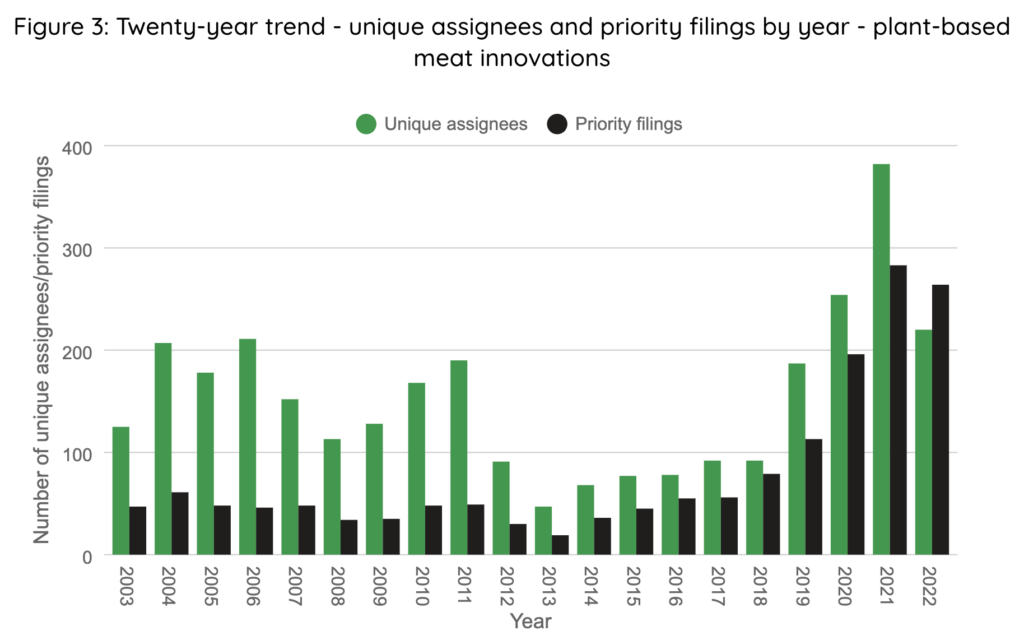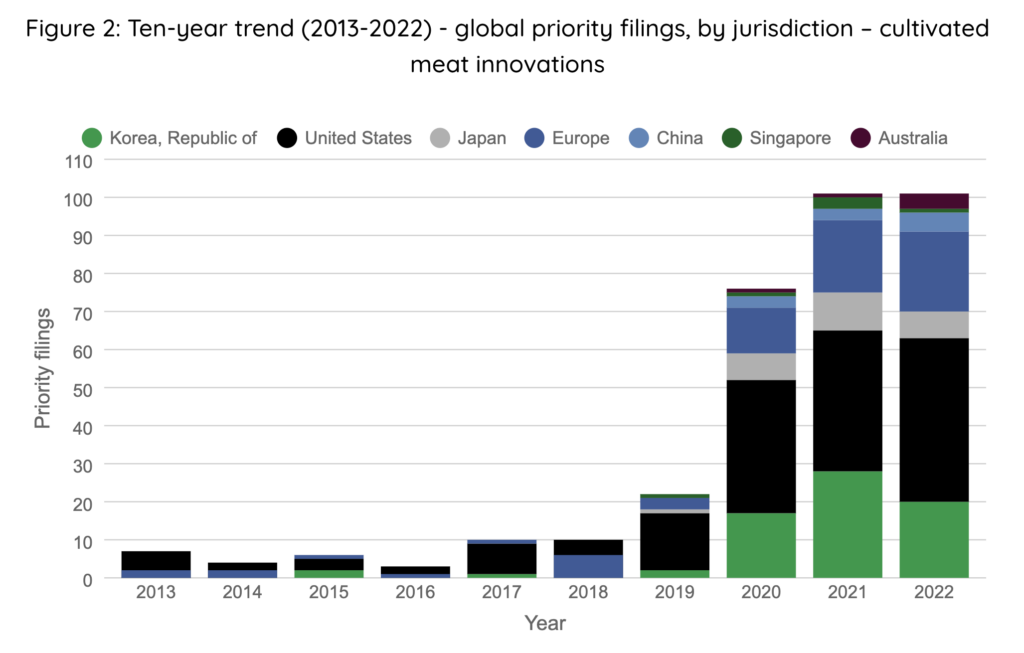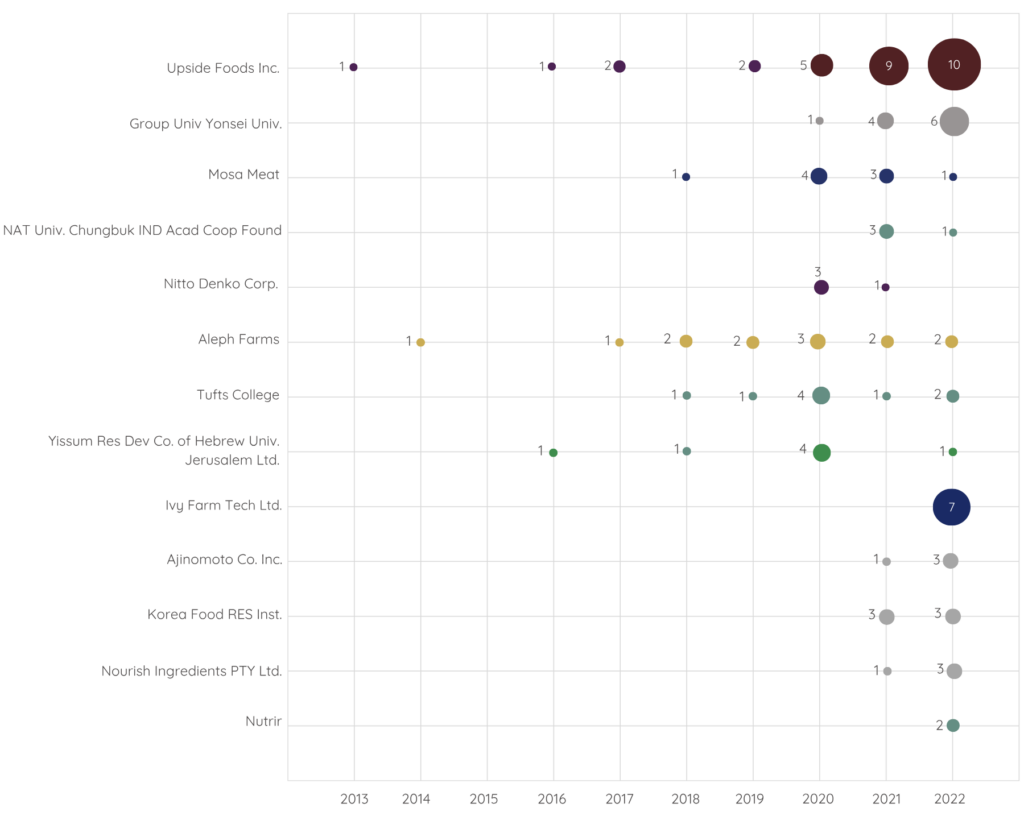Alternative Protein Innovation Has Lost Some Momentum, A New Patent Analysis Shows
5 Mins Read
Patents for plant-based meat declined for the first time in a decade in 2022, while innovation in cultivated meat slowed too.
In the US, sales of plant-based meat alternatives dipped by 26% between 2021 and 2023, reflecting a wider downturn for the alternative protein industry, which saw investment fall by 44% last year.
Against this backdrop, there has been a decline in innovation too, according to a new analysis of patent filings by IP firm Appleyard Lees. The fourth edition of its annual Inside Green Innovation: Progress Report examined global patent filings in the energy, transport and food sectors in 2022.
The research revealed that priority filings (the first patent application for a unique invention) for plant-based meat dropped for the first time in a decade (down by 7% in 2022) – but the year still represented the second-highest number of patents (264) in this segment.
“There was still significant funding in the plant-based meats industry in 2022, with over $1B of investment and a similar amount in governmental research funding announced through 2022 and 2023,” said Alice Smart, an associate at Appleyard Lees. “This shows that improving plant-based meats is still a topic that both investors and governments see as a potential solution to the problems of environmentally sustainable food production.”
At the same time, the fourfold increase in patent filings for cultivated meat from 2019-20 and a further rise the year after shrunk to just a 3% hike in 2022, indicating a loss in momentum amid a fall in investment levels.
“Global investment in cultivated meat and seafood companies fell from $922.3M in 2022 to $225.9M in 2023,” noted Appleyard Lees partner Chris Mason. “The top five cell-based meat manufacturers accounted for 46.9% of all funds raised and this has created a challenging environment for any new start-up firms entering the industry.”
Plant-based meat patents remain strong despite setback

The report attributed the fall in plant-based meat patent filings to the sustained drop in sales, in part due to consumer concerns around ultra-processed foods and dissatisfaction with the taste and texture of these products. The 77% price premium for meat alternatives, and late filing activity due to the impact of Covid-19 could also have played a role.
The numbers were still strong, though, indicating that confidence in the sector isn’t entirely lost. Patent applications for pea and soy protein lead the way, with wheat in third place. Tofu and tempeh patents, while representing a sixth of soy and pea, were the only ones that didn’t decline in 2022.
While flavour took the edge over texture in terms of patent focus in 2020, applications focused on the latter slightly outnumbered taste-centric filings in 2022. And although Europe and the US saw the most patents filed for plant-based meat, South Korea emerged as the hotbed for innovation, with the number of applications increasing.

Nestlé was overtaken as the innovation leader in 2022, when its plant-based patent filings halved from 17 to nine, focusing on protein binders, connective tissue analogues, and texture improvements. Instead, French ingredient company Roquette Freres doubled its filings (10) to emerge as the leading patent applier, centred on texture and flavour enhancements for pea protein.
“Plant-based meats offer a potentially more environmentally sustainable alternative to ‘real’ meat but reducing the cost of producing and retailing plant-based meats combined with improving the nutritional profile may be required to reinvigorate the industry,” said Mason.
Scale-up and regulatory approvals key for cultivated meat innovation

With cultivated meat, stalled innovation may be a result of a shift in focus towards scaling up production, which remains the industry’s major bottleneck. A lack of investment may have also played a part: startups in this category received 75% less money from venture capitalists in 2023, and so far this year, they have only attracted half of last year’s total. In fact, in Q3, only $3M was poured into this sector.
The US led the field by some distance, being responsible for over two in five cultivated meat patents filed in 2020. In terms of companies, California’s Upside Foods applied for the most patents (10), followed by British firm Ivy Farm Technologies (seven).
The latest filings in this sector sought to protect equipment and methods to reduce production costs and increase capacity, like bioreactors and suspension cell cultures. They were accompanied by other applications surrounding culture media (comprising nutritional components and ingredients) and ways to better mimic the taste, texture and aroma of conventional meat.

Appleyard Lees suggests that the hike in regulatory approvals this year (with four products being cleared for sale across four countries) is a marker of the industry’s progress. The UK greenlight for London’s Meatly, which makes cultivated pet food, is particularly noteworthy, as it could “pave the way for more countries to approve cultivated meat for pet food, leading to further innovation in this field”.
“In the cultivated meat sector, scaling up is clearly the current focus and the biggest technological obstacle to further development faced by the more established companies in this sector,” said Smart. “The desire to create an affordable and sustainable product is driving innovations in high volume methods, accelerated production and ways to make the culturing process more efficient.”
She added: “This push to scale up will need to move in parallel with progressive regulatory and funding environments to see this industry of high potential move to the next level.”



